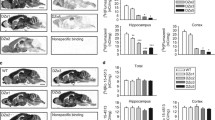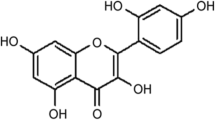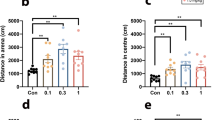Abstract
Rationale
(1S,2S,5R,6S)-2-Aminobicyclo[3.1.0]hexane-2,6-dicarboxylic acid (LY354740) is a potent and selective agonist for group II metabotropic glutamate (mGlu2 and mGlu3) receptors, with anxiolytic-like activity in animal and human models, and efficacy in anxiety patients. However, the lack of mGlu2 or mGlu3 receptor specific agonists has prevented in vivo characterization of individual functions of these two receptors in mediating the anxiolytic-like effects of LY354740.
Objective
To utilize mGlu2 receptor and mGlu3 receptor knockout animals and the mGlu2/3 selective antagonist (2S,1′S,2′S)-2-(9-xanthylmethyl)-2-(2′-carboxycyclopropyl)glycine (LY341495) to further investigate the roles of mGlu2 and mGlu3 receptors in mediating the anxiolytic-like actions of LY354740 in a mouse model of anxiety [elevated plus maze (EPM) test].
Methods
To confirm that mGlu2/3 receptors are responsible for anxiolytic-like activity in the EPM under these test conditions, mice were pretreated with LY341495 at 30 min prior to s.c. administered LY354740. Subsequently, saline vehicle or LY354740 was administered (s.c.) 30 min before the EPM testing in wild-type, mGlu2 receptor knockout, and mGlu3 receptor knockout mice.
Results
LY354740 reduced in a dose-dependent manner anxiety-related behavior on the EPM in wild-type mice with a maximally effective dose of 10–20 mg/kg s.c. Pretreatment with LY341495 potently prevented the anxiolytic-like effects of LY354740 (20 mg/kg, s.c.) in mice. Although the mGlu2 receptor knockout and mGlu3 receptor knockout mice were grossly normal, the anxiolytic-like activity of LY354740 (20 mg/kg, s.c.) was not evident in either mGlu2 or mGlu3 receptor knockout mice, when compared to their wild-type controls.
Conclusions
The activation of both mGlu2 and mGlu3 receptors by LY354740 appears to be required for anxiolytic-like activity in the EPM test in mice. These studies serve as a foundation for additional studies on underlying circuits, brain structures, and receptor subtypes involved in the anxiolytic-like actions of mGlu receptor active agents, and the design of future drugs for anxiety disorders in humans.






Similar content being viewed by others
References
Anwyl R (1999) Metabotropic glutamate receptors: electrophysiological properties and role in plasticity. Brain Res Rev 29:83–120
Cartmell J, Schoepp DD (2000) Regulation of neurotransmitter release by metabotropic glutamate receptors. J Neurochem 75:889–907
Conn PJ, Pin J-P (1997) Pharmacology and functions of metabotropic glutamate receptors. Annu Rev Pharmacol Toxicol 37:205–237
Ferris P, Seward E, Dawson GR (2001) Interactions between LY354740, a group II metabotropic agonist and the GABAA-benzodiazepine receptor complex in the rat elevated plus maze. J Psychopharmacol 15:76–82
Grillon C, Cordova J, Levine L, Morgan C III (2003) Anxiolytic effects of a novel group II metabotropic glutamate receptor agonist (LY354740) in the fear-potentiated startle paradigm in humans. Psychopharmacology (Berl)
Helton DR, Tizzano JP, Monn JA, Schoepp DD, Kallman MJ (1998) Anxiolytic and side-effect profile of LY354740: a potent, highly selective, orally active agonist for group III metabotropic glutamate receptors. J Pharmacol Exp Ther 284:651–660
Higgins GA, Ballard TM, Kew JNC, Richards JG, Kemp JA, Adam G, Woltering T, Nakanishi S, Mutel V (2004) Pharmacological manipulation of mGlu2 receptors influences cognitive performance in the rodent. Neuropharmacology 46:907–917
Irwin S (1968) Comprehensive observational assessment: IA. A systematic, quantitative procedure for assessing the behavioral and physiologic state of the mouse. Psychopharmacologia 13:222–257
Kew JNC, Pflimlin M-C, Kemp JA, Mutel V (2002) Differential regulation of synaptic transmission by mGlu2 and mGlu3 at the perforant path inputs to the dentate gyrus and CA1 revealed in mGlu2 −/− mice. Neuropharmacology 43:215–221
Kingston A, Ornstein P, Wright R, Johnson B, Mayne N, Burnett J, Belagaje R, Wu S, Schoepp D (1998) LY341495 is a nanomolar potent and selective antagonist of group II metabotropic glutamate receptors. Neuropharmacology 37:1–12
Klodzinska A, Chojnacka-Wojcik E, Palucha A, Branski P, Popik P, Pilc A (1999) Potential anti-anxiety, anti-addictive effects of LY354740, a selective group II glutamate metabotropic receptors agonist in animal models. Neuropharmacology 38:1831–1839
Linden A-M, Johnson BG, Peters SC, Shannon HE, Tian M, Wang Y, Yu JL, Koster A, Baez M, Schoepp DD (2002) Increased anxiety-related behavior in mice deficient for metabotropic glutamate 8 (mGlu8) receptor. Neuropharmacology 43:251–259
Linden A-M, Greene SJ, Bergeron M, Schoepp DD (2004) Anxiolytic activity of the mGlu2/3 receptor agonist LY354740 is associated with the suppression of stress-induced c-Fos in the hippocampus and the increases in c-Fos induction in the several other stress-sensitive brain regions. Neuropsychopharmacology 29:502–513
Lister RG (1987) The use of a plus-maze to measure anxiety in the mouse. Psychopharmacology 92:180–185
Monn JA, Valli MJ, Massey SM, Wright RA, Salhoff CR, Johnson BG, Howe T, Alt CA, Rhodes GA, Robey RL, Griffey KR, Tizzano JP, Kallman MJ, Helton DR, Schoepp DD (1997) Design, synthesis, and pharmacological characterization of (+)-2-aminobicyclo[3.1.0]hexane-2,6-dicarboxylic acid (LY354740): a potent, selective, and orally active group 2 metabotropic glutamate receptor agonist possessing anticonvulsant and anxiolytic properties. J Med Chem 40:528–537
Ohishi H, Shigemoto R, Nakanishi S, Mizuno N (1993a) Distribution of the messengers RNA for a metabotropic glutamate receptor, mGluR2, in the central nervous system of the rat. Neuroscience 53:1009–1018
Ohishi H, Shigemoto R, Nakanishi S, Mizuno N (1993b) Distribution of the mRNA for a metabotropic glutamate receptor (mGluR3) in the rat brain: an in situ hybridization study. J Comp Neurol 335:252–266
Ornstein P, Bleisch T, Arnold M, Kennedy J, Wright R, Johnson B, Tizzano J, Helton D, Kallman M, Schoepp D, Herin M (1998) 2-substituted (2SR)-2-amino-2-((1SR,2SR)-2-carboxycycloprop-1-yl)glycines as potent and selective antagonists of group II metabotropic glutamate receptors. 2. Effects of aromatic substitution, pharmacological characterization, and bioavailability. J Med Chem 41:358–378
Schoepp DD (2001) Unveiling the function of presynaptic metabotropic glutamate receptors in the central nervous system. J Pharmacol Exp Ther 299:12–20
Schoepp DD, Jane DE, Monn JA (1999a) Pharmacological agents acting at subtypes of metabotropic glutamate receptors. Neuropharmacology 38:1431–1476
Schoepp DD, Monn JA, Marek GJ, Aghajanian G, Moghaddam B (1999b) LY354740: a systemically active mGlu2/3 receptor agonist. CNS Drug Rev 5:1–12
Schoepp DD, Wright RA, Levine LR, Gaydos B, Potter WZ (2003) LY354740, an mGlu2/3 receptor agonist as a novel approach to treat anxiety/stress. Stress 6:189–197
Shekhar A, Keim SR (2000) LY354740, a potent group II metabotropic glutamate receptor agonist prevents lactate-induced panic-like response in panic-prone rats. Neuropharmacology 39:1139–1146
Shigemoto R, Kinoshita A, Wada E, Nomura S, Ohishi H, Takada M, Flor PJ, Neki A, Abe T, Nakanishi S, Mizuno N (1997) Differential presynaptic localization of metabotropic glutamate receptor subtypes in the rat hippocampus. J Neurosci 17:7503–7522
Spooren W, Gasparini F, van der Putten H, Koller M, Nakanishi S, Kuhn R (2000) Lack of effect of LY314582 (a group 2 metabotropic glutamate receptor agonist) on phencyclidine-induced locomotor activity in metabotropic glutamate receptor 2 knockout mice. Eur J Pharmacol 397:R1–R2
Spooren W, Gasparini F, Salt T, Kuhn R (2001) Novel allosteric antagonists shed light on mlgu5 receptors in CNS disorders. Trends Pharmacol Sci 22:331–337
Spooren WPJM, Schoeffter P, Gasparini F, Kuhn R, Gentsch C (2002) Pharmacological and endocrinological characterization of stress-induced hyperthermia in singly housed mice using classical and candidate anxiolytics (LY314582, MPEP and NKP608). Eur J Pharmacol 435:161–170
Tamaru Y, Nomura S, Mizuno N, Shigemoto R (2001) Distribution of metabotropic glutamate receptor mGluR3 in the mouse CNS: differential location relative to pre- and postsynaptic sites. Neuroscience 106:481–503
Tatarczynska E, Klodzinska A, Kroczka B, Chojnacka-Wojcik E, Pilc A (2001) The antianxiety-like effects of antagonists of group I and agonists of group II and III metabotropic glutamate receptors after intrahippocampal administration. Psychopharmacology (Berl) 158:94–99
Tizzano JP, Griffey KI, Schoepp DD (2002) The anxiolytic action of mGlu2/3 receptor agonist LY354740 in fear potentiated startle model in rats is independent of GABAergic modulation and mechanistically distinct from diazepam. Pharmacol Biochem Behav 73:367–374
Walker D, Rattiner L, Davis M (2002) Group II metabotropic glutamate receptors within the amygdala regulate fear as assessed with potentiated startle in rats. Behav Neurosci 116:1075–1083
Yokoi M, Kobayashi K, Manabe T, Takahashi T, Sakaguchi I, Katsuura G, Shigemoto R, Ohishi H, Nomura S, Nakamura K, Nakao K, Katsuki M, Nakanishi S (1996) Impairment of hippocampal mossy fiber LTD in mice lacking mGluR2. Science 273:645–647
Zhai J, Tian MT, Wang Y, Yu JL, Koster A, Baez M, Nisenbaum ES (2002) Modulation of lateral perforant path excitatory responses by metabotropic glutamate 8 (mGlu8) receptors. Neuropharmacology 43:223–230
Author information
Authors and Affiliations
Corresponding author
Rights and permissions
About this article
Cite this article
Linden, AM., Shannon, H., Baez, M. et al. Anxiolytic-like activity of the mGLU2/3 receptor agonist LY354740 in the elevated plus maze test is disrupted in metabotropic glutamate receptor 2 and 3 knock-out mice. Psychopharmacology 179, 284–291 (2005). https://doi.org/10.1007/s00213-004-2098-x
Received:
Accepted:
Published:
Issue Date:
DOI: https://doi.org/10.1007/s00213-004-2098-x




